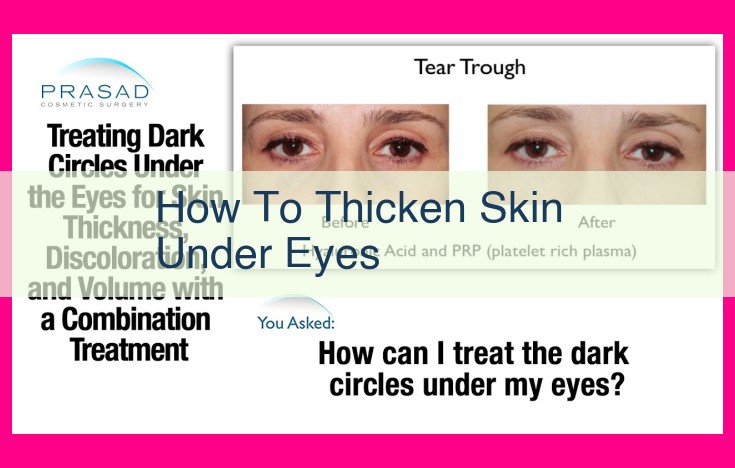Top Solutions For Thickening Thin Under-Eye Skin: Explore Treatment Options And Expert Advice

To thicken under-eye skin, consider professional treatments such as plastic surgery, aesthetician recommendations, or over-the-counter products from cosmetic and skincare companies. For guidance, refer to reputable medical journals and websites.
Causes of Thin Under-Eye Skin
The delicate skin beneath our eyes, known as the periorbital area, is prone to thinning as we age. This can lead to a host of concerns, from the appearance of fine lines and wrinkles to the development of dark circles and puffiness.
Understanding the Skin’s Structure
To grasp why the under-eye skin is more susceptible to thinning, it’s essential to comprehend its unique structure. This area is composed of several layers, including the outermost epidermis, the middle dermis, and the innermost subcutaneous tissue. The dermis, rich in collagen and elastin, provides strength and resilience to the skin, while the subcutaneous tissue adds volume and support.
Factors Contributing to Thinning
As we age, the production of collagen and elastin naturally declines, leading to a weakening of the skin’s support structure. This, combined with the thinness of the under-eye skin, makes it prone to atrophy, or the thinning of the skin. Additionally, factors such as genetics, sun exposure, and certain medications can further contribute to the loss of skin thickness in this area.
Sun Exposure
Ultraviolet (UV) radiation from the sun is one of the most significant factors contributing to premature skin aging. UV rays damage the skin’s collagen and elastin fibers, accelerating the thinning process. Moreover, the under-eye area is often exposed to the sun without adequate protection, making it particularly vulnerable to this damage.
Genetics
Genetics plays a substantial role in determining the thickness and quality of our skin. Individuals with inherently thin skin are more likely to experience under-eye thinning earlier in life.
Medications
Certain medications, such as corticosteroids, can have the side effect of thinning the skin. These medications are often used to treat conditions like eczema and asthma, but they can also weaken the skin’s structure if used long-term.
Professional Options to Thicken Under-Eye Skin
The delicate skin under our eyes often bears the brunt of time and environmental factors, becoming thin and revealing underlying blood vessels. While there are over-the-counter products and home remedies to address this issue, professional treatments offer more effective and long-lasting solutions.
Dermatologists: The Skin Experts
Licensed dermatologists possess the knowledge and experience to accurately assess the underlying causes of thin under-eye skin. They can recommend appropriate treatments based on your individual skin type and condition. For example, they may prescribe topical creams containing retinol or peptides to stimulate collagen production.
Plastic Surgery: A Surgical Solution
For more severe cases, plastic surgery may be necessary to rejuvenate the under-eye area. Blepharoplasty is a surgical procedure that removes excess skin and fat, tightening the skin and reducing the appearance of fine lines and wrinkles. This option offers dramatic results but requires a longer recovery time.
Aestheticians: Skin Care Specialists
Aestheticians are licensed professionals who offer non-invasive treatments to improve skin quality. They can provide guidance on skincare products, recommend specific facials and masks, and perform microdermabrasion or chemical peels to exfoliate the skin and stimulate collagen production. While these treatments are less invasive than plastic surgery, they may require multiple sessions to achieve significant results.
Choosing the Right Option
The best professional option for thickening under-eye skin depends on several factors, including the severity of the condition, desired results, and personal preferences. It’s important to consult with a qualified professional to determine the most appropriate treatment plan for your individual needs.
Over-the-Counter Options for Thicker Under-Eye Skin
Your under-eye area is delicate and prone to thinning as you age. But don’t worry – there are plenty of products available to help you get thicker, healthier-looking under-eye skin.
Cosmetic Company Solutions
Cosmetic companies have developed a wide range of products specifically designed to address thin under-eye skin. These products often contain ingredients like hyaluronic acid, peptides, and vitamins that can help to hydrate, nourish, and protect the skin.
One popular option is the Estee Lauder Advanced Night Repair Eye Concentrate Matrix. This serum contains hyaluronic acid to hydrate the skin and peptides to stimulate collagen production. Another effective choice is the Lancome Genifique Yeux Light-Pearl Eye-Illuminating Serum. This serum contains bifidus extract, which is believed to help strengthen the skin’s barrier function.
Skincare Product Range
Skincare product manufacturers also offer a variety of products that can help to thicken under-eye skin. These products typically come in the form of serums, creams, or masks.
Serums are lightweight and designed to be absorbed quickly into the skin. Creams are thicker and provide more hydration. Masks are typically applied for a short period to provide a more intense treatment.
When choosing an over-the-counter product, look for products that contain ingredients that are known to benefit the under-eye area, such as hyaluronic acid, peptides, vitamins C and E, and green tea extract.
Scientific Evidence and Medical Sources
When navigating the vast sea of information on thin under-eye skin, it’s crucial to seek out reliable sources that provide evidence-based insights. Reputable medical journals, research papers, and healthcare professionals can offer valuable guidance.
Consulting peer-reviewed studies published in journals like JAMA Dermatology or Plastic and Reconstructive Surgery ensures that the information you’re consuming has been thoroughly evaluated by experts. These studies meticulously document the effects of treatments and provide insights into the underlying causes of thin under-eye skin.
Moreover, scientific research is constantly evolving, presenting new discoveries and advancements. By staying up-to-date with the latest medical sources, you can ensure that your understanding of skin aging and treatment options is always current and accurate.
Remember, trustworthy medical sources are the cornerstone of informed decision-making when it comes to your skin health. By seeking out reliable information, you empower yourself with the knowledge necessary to make choices that are in your best interest.